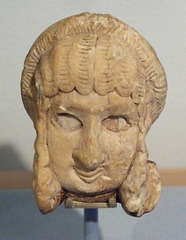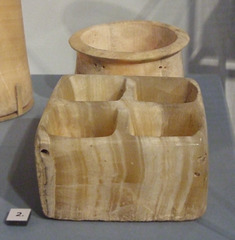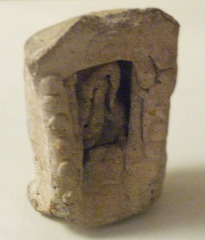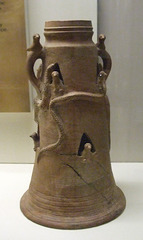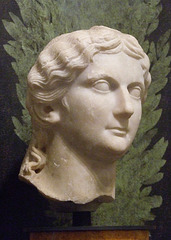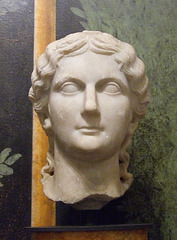LaurieAnnie's photos
Bull Head from the Sound Box of a Lyre in the Univ…
| |
|
Sumerian Electrum Tumbler in the University of Pen…
| |
|
Tumbler
Electrum
2550-2450 BCE
Ur, Iraq, (PG800, Tomb Chamber)
# B17691
This drinking vessel has been hammered out of a single piece of electrum, an alloy of gold and silver. It most likely would have been used at a royal banquet. Although it is made out of a precious metal, its design and fluted shape are typical of Mesopotamian drinking vessels. Examples can be seen in representations on cylinder seals and lyre panels. The loop on the rim suggests that the tumbler may have been hung around the neck or looped around the wrist with string or wire.
Text from the U. Penn. Museum label
Sumerian Helmet in the University of Pennsylvania…
| |
|
Helmet
Electrotype
2550-2450 BCE
Ur, Iraq (PG755)
# 29-22-2
Woolley had a series of electrotype reproductions made of all of the gold objects from the Royal Cemetery. The originals of the pieces seen here are in the Iraq Museum, Baghdad. The bull's head belonged to an elaborately decorated lyre from PG1237. The helmet was discovered in an extremely lavish burial, PG755. Several objects in the tomb mention Meskalamdug. A cylinder seal of Meskalamdug, the king, was found in another royal tomb. There is disagreement over whether or not the burial in PG755 was the king of that name.
Text from two U. Penn. Museum labels.
Sumerian Helmet in the University of Pennsylvania…
| |
|
Helmet
Electrotype
2550-2450 BCE
Ur, Iraq (PG755)
# 29-22-2
Woolley had a series of electrotype reproductions made of all of the gold objects from the Royal Cemetery. The originals of the pieces seen here are in the Iraq Museum, Baghdad. The bull's head belonged to an elaborately decorated lyre from PG1237. The helmet was discovered in an extremely lavish burial, PG755. Several objects in the tomb mention Meskalamdug. A cylinder seal of Meskalamdug, the king, was found in another royal tomb. There is disagreement over whether or not the burial in PG755 was the king of that name.
Text from two U. Penn. Museum labels.
Harp Ornament in the University of Pennsylvania Mu…
| |
|
Harp Ornament
Electrotype
2550-2450 BCE
Ur, Iraq (PG1237)
# 31-18-10
Woolley had a series of electrotype reproductions made of all of the gold objects from the Royal Cemetery. The originals of the pieces seen here are in the Iraq Museum, Baghdad. The bull's head belonged to an elaborately decorated lyre from PG1237. The helmet was discovered in an extremely lavish burial, PG755. Several objects in the tomb mention Meskalamdug. A cylinder seal of Meskalamdug, the king, was found in another royal tomb. There is disagreement over whether or not the burial in PG755 was the king of that name.
Text from two U. Penn. Museum labels.
Sumerian Gold Wreath in the University of Pennsylv…
| |
|
Wreath
Gold, Lapis lazuli, and carnelian
2550-2450 BCE
Ur, Iraq (PG789)
# B16740
Text from the U. Penn. Museum label.
Gold
Gold would have been imported from Anatolia, Iran, and the Indus valley. At Ur, golden objects are almost always made of alloys of gold and coppper or gold and silver. Pure gold is extremely rare. This is probably both because gold was a scarce and precious commodity, and because the color and appearance of the alloys was preferred. Gold and copper alloy is reddish, whild gold and silver (electrum) is silvery.
Text from the U. Penn. Museum label.
Sumerian Choker in the University of Pennsylvania…
| |
|
Choker
Gold and lapis lazuli
2550-2450 BCE
Ur, Iraq (PG1237, Body No. 16)
# 30-12-706
Text from the U. Penn. Museum label.
Gold
Gold would have been imported from Anatolia, Iran, and the Indus valley. At Ur, golden objects are almost always made of alloys of gold and coppper or gold and silver. Pure gold is extremely rare. This is probably both because gold was a scarce and precious commodity, and because the color and appearance of the alloys was preferred. Gold and copper alloy is reddish, whild gold and silver (electrum) is silvery.
Text from the U. Penn. Museum label.
Sumerian Gold Bowl in the University of Pennsylvan…
| |
|
Bowl
Gold
2550-2450 BCE
Ur, Iraq (PG800, Tomb Chamber)
B17693
These gold containers were found in Queen Puabi's tomb chamber. The oval shape of the two bowls is a common metal vessel form. The fluted bowl shares many design elements with the fluted tumbler, and they may be thought of as a set. The cosmetic container, shaped as a cockleshell, was filled with a green pigment. The pieces are in such good condition because gold is a stable metal.
Text from two U. Penn. Museum labels.
Gold
Gold would have been imported from Anatolia, Iran, and the Indus valley. At Ur, golden objects are almost always made of alloys of gold and coppper or gold and silver. Pure gold is extremely rare. This is probably both because gold was a scarce and precious commodity, and because the color and appearance of the alloys was preferred. Gold and copper alloy is reddish, whild gold and silver (electrum) is silvery.
Text from the U. Penn. Museum label.
Sumerian Gold Bowl in the University of Pennsylvan…
| |
|
Bowl
Gold
2550-2450 BCE
Ur, Iraq (PG800, Tomb Chamber)
B16707
These gold containers were found in Queen Puabi's tomb chamber. The oval shape of the two bowls is a common metal vessel form. The fluted bowl shares many design elements with the fluted tumbler, and they may be thought of as a set. The cosmetic container, shaped as a cockleshell, was filled with a green pigment. The pieces are in such good condition because gold is a stable metal.
Text from two U. Penn. Museum labels.
Gold
Gold would have been imported from Anatolia, Iran, and the Indus valley. At Ur, golden objects are almost always made of alloys of gold and coppper or gold and silver. Pure gold is extremely rare. This is probably both because gold was a scarce and precious commodity, and because the color and appearance of the alloys was preferred. Gold and copper alloy is reddish, whild gold and silver (electrum) is silvery.
Text from the U. Penn. Museum label.
Sumerian Gold Earrings in the University of Pennsy…
| |
|
(top) Earring
Gold
2550-2450 BCE
Ur, Iraq (PG 1237)
# 30-12-442 A
and (bottom) Earring
Gold
2550-2450 BCE
Ur, Iraq (PG 1237)
# 30-12-442 B
Gold
Gold would have been imported from Anatolia, Iran, and the Indus valley. At Ur, golden objects are almost always made of alloys of gold and coppper or gold and silver. Pure gold is extremely rare. This is probably both because gold was a scarce and precious commodity, and because the color and appearance of the alloys was preferred. Gold and copper alloy is reddish, whild gold and silver (electrum) is silvery.
Text from the U. Penn. Museum label.
Sumerian Vessel in the Form of an Ostreich Egg in…
| |
|
Vessel in the Form of an Ostreich Egg
Gold, lapis lazuli, red limestone, shell, and bitumen
2550-2450 BCE
Ur, Iraq (PG779)
B16692
Text from the U. Penn. Museum label.
Gold
Gold would have been imported from Anatolia, Iran, and the Indus valley. At Ur, golden objects are almost always made of alloys of gold and coppper or gold and silver. Pure gold is extremely rare. This is probably both because gold was a scarce and precious commodity, and because the color and appearance of the alloys was preferred. Gold and copper alloy is reddish, whild gold and silver (electrum) is silvery.
Text from the U. Penn. Museum label.
Sumerian Female Statue Fragment in the University…
| |
|
Statue Fragment (female)
Alabaster
2600-2350 BCE
Khafaje, Iraq
# 38-10-51
Text from the U. Penn. Museum label.
Sumerian Alabaster Cosmetic Box in the University…
| |
|
Cosmetic Box
Alabaster
2550-2450 BCE
Ur, Iraq (PG1100)
# 30-12-697
Text from the U. Penn. Museum label.
Model Shrine in the University of Pennsylvania Mus…
| |
|
Model Shrine
Ceramic
Amathus, Cyprus
ca. 600 BC
# MS 156
Model shrines such as this one are associated with the Phoenicians and their expansion westward into the Mediterranean. Note the typical Phoenician stylistic features like the crescent moon and sun-disk above the doorway and the proto-Aeolic column capitals.
Text from the U. Penn Museum label.
Offering Stand from Beth Shean in the University o…
| |
|
Offering Stand
Ceramic
Beth Shean, stratum V, south temple
Iron IB, 1150-1000 BCE
# 29-103-830
This offering stand is decorated with birds and snakes. These animals commonly appear on ritual objects throughout the eastern Mediterranean, though their symbolic significance remains unknown.
Text from the U. Penn. Museum label.
Marble Portrait of Agrippina the Elder in the Univ…
| |
|
Marble Portrait of Agrippina the Elder
Probably from near Troy
ca. AD 38-54
# MS 213
Agrippina the Elder (circa 14 BC- AD 33) was the daughter of Agrippa, Augustus's wealthy, lifelong friend and supporter, and Julia, his daughter. She married Germanicus, great-nephew of Augustus, and bore nine of his children. One of these was the future emperor, Caligula. When her husband died suddenly, perhaps of poisoning, Agrippina was banished from Rome and died of starvation in exile.
Text from the U. Penn. Museum label.
Marble Portrait of Agrippina the Elder in the Univ…
| |
|
Marble Portrait of Agrippina the Elder
Probably from near Troy
ca. AD 38-54
# MS 213
Agrippina the Elder (circa 14 BC- AD 33) was the daughter of Agrippa, Augustus's wealthy, lifelong friend and supporter, and Julia, his daughter. She married Germanicus, great-nephew of Augustus, and bore nine of his children. One of these was the future emperor, Caligula. When her husband died suddenly, perhaps of poisoning, Agrippina was banished from Rome and died of starvation in exile.
Text from the U. Penn. Museum label.
Roman Portrait Head in the University of Pennsylva…
| |
|












